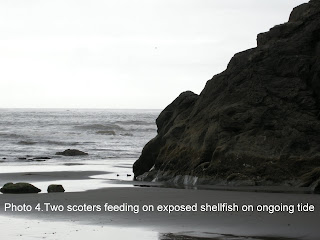Molt in scoters and many seabirds is a simultaneous molt. All flight feathers are lost and grown in a 3-4 week period. Unlike sequential molt, which allows birds to retain the ability to fly, birds are flightless during simultaneous molt. Body molt is also ongoing, resulting in lessening of the protective cover afforded by the body feathers, which can lead to loss of buoyancy and hypothermia. Molt timing and strategies evolve so that birds minimize risks during the period when flightless. Presumably molt staging areas are located in protected areas with plentiful food. However, on the outer coast it would seem that flightless birds would be continually hammered by the crashing surf and rocks in the shallow water they need for feeding. The protected waters of Puget Sound or Straits of Georgia would seem to be safer molting areas. From what I gather, there are few baseline data regarding the distribution of migrating scoters for the outer Washington coast, so it is unclear if the beached birds were indicators of an unknown staging area used for molt during migration, or if their presence was an anomaly, perhaps related to ENSO (El Nino/Southern Oscillation) that is developing in the Pacific.
A few known facts about scoter migration come from Birds of North America accounts. Molting areas are known for the coasts from Alaska south to BC. After females lay eggs, male scoters start moving to molting areas followed by females after scoterlings fledge. Juveniles are last to migrate and appear to skip molting areas and do not undergo wing molt. Notably, the beached birds were mostly adult males and there was only one juvenile. Using molts scores, I will be able to estimate the onset and completion of molt for this group which will provide significant data regarding timing of molt. In addition all the dead birds appeared to be emaciated, which can be confirmed from examination of salvaged specimens. Based on existing distributional data, it appears the birds were too far south, but perhaps they have just been missed because of insufficient surveys. Reportedly there was a combination of high surf, tides and wind over Labor Day weekend and beached birds started showing up two days later with peak numbers 3-4 days after Labor Day. The scoters might be doing a normal molt migration, but were trapped by the storm and forced ashore. It is also possible that ENSO has altered the ocean conditions or currents. Birds might have started molt at the normal time and place, but because of altered currents, they did not follow normal routes. The general consensus is that feeding is necessary during molt because molt is energetically costly. Perhaps they arrived in poor condition with insufficient reserves to make it through the molt, and their condition was exacerbated by the Labor Day Storm.
Another factor that could have caused mortality and is being tested is that an algae bloom resulted in a red tide and paralytic shellfish poisoning (PSP) which could kill birds outright. Indirect mortality can also result. The dinoflagellates associated with red tide can also produce a compound that is whipped into a foamy surfactant (soap) by the surf. This foam washes protective oil from feathers leading to loss of buoyancy and hypothermia, and birds come ashore as they attempt to cope. That latter mechanism, discovered in 2007, was the cause of stranding and mortality in Monterey Bay, California. However, I found none of the signs of surfactant-mediated mortality that were detailed in the original paper. There are many factors that could have contributed to the wreck, and my speculation highlights how little we know about some of the common bird species in the Northwest.
Gary Shugart







2 comments:
Hey Gary!
Glad to see you found lots of birds for the museum! But of course not as glad as I would be if they were still alive... Our freezer here is about to run out. We have maybe less than 5 birds left to skin, and with 3 students and myself skinning, it's going to be sad times in about a week with no birds. Every time I'm outside I'm on the look out for roadkill but the birds seem pretty scarce around here...
do eat jellyfish
Post a Comment